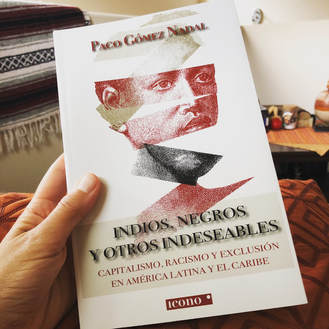La educación colonizadora y el protagonismo de la historia
Los estragos de la colonia y la colonialidad
Victimización y resistencia
El dominio del cuerpo “indeseable”
El eco en el cuerpo
Andres
9/7/2018 07:03:48 pm
Growing up in Colombia, I remember quite well, ´uuuf, no sea indio!´ when you said or did something that wasn´t up to speed with whatever pop cultural standard you happened to be navigating: Clothes, music, table manners, technology, etc...' and what´s interesting is how, when I moved to Miami, it was exactly the same thing, except it was now ´ref.´ This was short for refugee, a way that immigrants created castes for newly arrived Latinos versus established ones. Then, as I grew older, and the tension between Latinos and African American Miamians became clearer to me, it was ´ghetto.´If you scotch taped your light fixture: ghetto. If you took the laces out of your uncomfortable sneakers: Ghetto. If you called house music techno: ´bro, don´t be such a ref!´ The standards of judgment came from the cultural pyramid that was set by Europe and the U.S, and they really did manage to make you spend money in order to ´refine´ to their standards, which bent according to cultural taste-makers, no longer simply serving ´high society´ but now being employed as part of a particular brand of ´youth, freedom, rebellion´ and all the other beer commercial representations that had more to do with their exploitation of your developing hormones than with any actual ideology... Want to be a cool American? HATE poverty. Poverty will not get you laid. Poverty has no fashion sense, and it looks like this, and this, and this... I think that one of the reasons some of my students don´t get the colonial explanation is because of the cultural 180 that the U.S. primarily deployed by way of their marketing throughout the 20th century... the command to hate poverty was less about active and direct elimination of the brown and black body in the shared space, and more about the conceptual image being manipulated in everyone´s mind. It allowed capital to use a culture for what it wanted (music, fashion, language, athletics, cheap labor, sex) and dispose of what it didn´t... and Colombia seemed to follow suit, at least in my young experience of it.
Sandra Paola
9/14/2018 07:50:18 am
Hi Andrés! Thank you for your comment. I really appreciate your reflection and the connection between the castes that we create within our communities. My immigration to the US was in very different circumstances (I moved to the midwest to go to college) so I had never heard the expression "ref" (although it sadly doesn't surprise me). Hearing some of your story is a good reminder of the vastness of the immigrant experience and how intersectionality plays in how we relate to ourselves in any given moment. 9/15/2018 10:55:59 pm
Great post. Thank you Sandra Paola.
Sandra Paola
9/16/2018 06:36:18 pm
Thank you for your comment Suzy! I visualized the singer of A Samba que Las Querem as I read your description. What a powerful image. Indeed complacency in our countries of origin (and in the one we live in) is what I seek to avoid. I would perhaps change your question to "How can we keep doing?" As one of my mentors once said when referring to organizing community in new ways: "I don't know if what I am doing works, but at least I am doing something, and something is better than nothing."
Mateo Galindo Torres
9/16/2018 05:08:21 pm
Existen sin duda muchos ejemplos de los efectos de la colonización en los sistemas opresivos contemporáneos en Colombia. Desde cometarios como el “no sea indio” o la apropiación de palabras indígenas como lo son “Guache” y “Guaricha” dándoles un uso despectivo, hasta el concepto de la propiedad privada y la existencia de fronteras arbitrarias que dividen las tierras tradicionalmente indígenas. Estas realidades nos demuestran que el desprecio a lo indígena es latente.
Sandra Paola
9/29/2018 09:04:04 am
Gracias por tu comentario Mateo y por compartir tu trabajo. Me impactó mucho el contraste y juego entre las imágenes "fijas" en el dibujo y las efímeras que dejan marcadas tus movimientos. El conflicto de la identidad de colonizado y colonizador es palpable y resuenan las preguntas que haces con respecto a la coherencia de valores... ¿Cuál es nuestra responsabilidad? Comments are closed.
|

 RSS Feed
RSS Feed